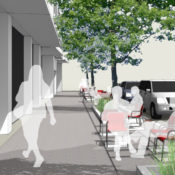Author: William Hawes Coleman II
CHAIR>bench by The Agile Landscape Project
The immobile nature of site furnishings has long been an issue for landscape architects and urban designers working in the public realm. While immobility is traditionally a necessary characteristic to prevent theft or vandalism, members of a Nashville, Tennessee think tank, The Agile Landscape Project, have been working towards an innovative solution that could bring mobility back to site furnishings.
Heavily influenced by the maker movement, tactical urbanism, and the Lean Startup philosophy, The Agile Landscape Project has developed their own hands-on experimentation driven approach to addressing issues and discovering design solutions. This approach is focused around creating minimum viable products that will be used for “Adaptive Generative” and “Intelligent Landscape Experimentation” in today’s urban laboratories. “People want to touch and experience an idea,” explains project lead, Brian Phelps. “Obviously, they can’t do this with computer renderings very effectively. So I decided to start building.”
The Agile Landscape Project (TALP) has recently hit the streetscape with their first prototype for movable site furniture, the CHAIR>bench project. CHAIR>bench addresses the issue of mobility through the creation of a track and sled system that nearly any site-furnishing element (tables, chairs, etc.) can be attached. This system works to eliminate the concern of theft, while providing similar freedom of movement to traditional movable furnishings.
This track and sled technology invented by TALP is a seemingly simple yet innovative system that provides a vast range of potential configurations and encourages user interaction. Each piece of site furniture is attached to a sled, which has the ability to be moved anywhere along the track. The sleds can also rotate 360 degrees on a central axis, providing even more options for spatial configuration. The system can also take on any scale or configuration based on site needs.
In addition to this, the track has the ability to take on many different shapes or patterns providing almost limitless configuration. In addition to its innovative physical form, the CHAIR>bench prototype exhibits an intelligent digital component to the project through a network of sensors embedded within. These sensors provide real time feedback charting spatial use and chair movement.
“…a wonderful invention – the movable chair…the big asset is moveability. Chairs enlarge choice: to move into the sun, out of it, to make room for groups, move away from them. The possibility of choice is as important as the exercise of it…There declarations of autonomy to one self, and rather satisfying.”
– William Whyte ‘Social Life of Small Urban Spaces’
The digital feedback is also used as a means of responding to the user. This is accomplished though playing selected audio clips when the chairs are arranged in different configurations. Each clip is taken from William Whyte’s, ‘Social Life of Small Urban Spaces’ and discusses the importance of movable seating in the public landscape. One inspirational Whyte clip harps on the importance of mobility.
The Youtube video below shows the CHAIR>bench project in action on the streets of Nashville:
The Agile Landscape Project is lead by Brian Phelps, a landscape architect and urban designer out of Nashville, TN. Mr. Phelps is a senior associate at Hawkins Partners, Inc a landscape architecture and urban design firm in Nashville, as well as the co-founder of sitephocus.com.
More information regarding the CHAIR>bench project, as well as, The Agile Landscape Project can be found at http://theagilelandscape.com
All images courtesy of The Agile Landscape Project





